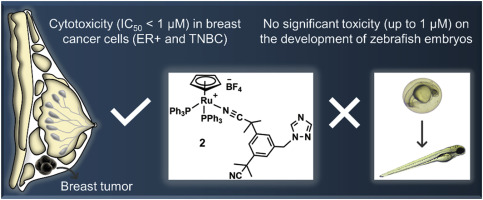当前位置:
X-MOL 学术
›
Eur. J. Med. Chem.
›
论文详情
Our official English website, www.x-mol.net, welcomes your
feedback! (Note: you will need to create a separate account there.)
Synthesis and biological assessment of a ruthenium(II) cyclopentadienyl complex in breast cancer cells and on the development of zebrafish embryos.
European Journal of Medicinal Chemistry ( IF 6.0 ) Pub Date : 2020-01-03 , DOI: 10.1016/j.ejmech.2019.112030 Golara Golbaghi 1 , Irène Pitard 1 , Matthieu Lucas 1 , Mohammad Mehdi Haghdoost 1 , Yossef López de Los Santos 1 , Nicolas Doucet 1 , Shunmoogum A Patten 1 , J Thomas Sanderson 1 , Annie Castonguay 1
European Journal of Medicinal Chemistry ( IF 6.0 ) Pub Date : 2020-01-03 , DOI: 10.1016/j.ejmech.2019.112030 Golara Golbaghi 1 , Irène Pitard 1 , Matthieu Lucas 1 , Mohammad Mehdi Haghdoost 1 , Yossef López de Los Santos 1 , Nicolas Doucet 1 , Shunmoogum A Patten 1 , J Thomas Sanderson 1 , Annie Castonguay 1
Affiliation

|
Ruthenium-based complexes currently attract great attention as they hold promise to replace platinum-based drugs as a first line cancer treatment. Whereas ruthenium arene complexes are some of the most studied species for their potential anticancer properties, other types of ruthenium complexes have been overlooked for this purpose. Here, we report the synthesis and characterization of Ru(II) cyclopentadienyl (Cp), Ru(II) cyclooctadienyl (COD) and Ru(III) complexes bearing anastrozole or letrozole ligands, third-generation aromatase inhibitors currently used for the treatment of estrogen receptor positive (ER +) breast cancer. Among these complexes, Ru(II)Cp 2 was the only one that displayed a high stability in DMSO and in cell culture media and consequently, the only complex for which the in vitro and in vivo biological activities were investigated. Unlike anastrozole alone, complex 2 was considerably cytotoxic in vitro (IC50 values < 1 μM) in human ER + breast cancer (T47D and MCF7), triple negative breast cancer (TNBC) (MBA-MB-231), and in adrenocortical carcinoma (H295R) cells. Theoretical (docking simulation) and experimental (aromatase catalytic activity) studies suggested that an interaction between 2 and the aromatase enzyme was not likely to occur and that the bulkiness of the PPh3 ligands could be an important factor preventing the complex to reach the active site of the enzyme. Exposure of zebrafish embryos to complex 2 at concentrations around its in vitro cytotoxicity IC50 value (0.1-1 μM) did not lead to noticeable signs of toxicity over 96 h, making it a suitable candidate for further in vivo investigations. This study confirms the potential of Ru(II)Cp complexes for breast cancer therapy, more specifically against TNBCs that are usually not responsive to currently used chemotherapeutic agents.
中文翻译:

乳腺癌细胞中钌(II)环戊二烯基复合物的合成和生物学评估以及对斑马鱼胚胎发育的影响。
钌基配合物目前引起了极大的关注,因为它们有望取代铂基药物作为一线癌症治疗方法。虽然钌芳烃络合物因其潜在的抗癌特性而成为研究最多的物种之一,但其他类型的钌络合物为此目的而被忽视。在这里,我们报道了带有阿那曲唑或来曲唑配体的 Ru(II) 环戊二烯基 (Cp)、Ru(II) 环辛二烯基 (COD) 和 Ru(III) 配合物的合成和表征,这些配合物是目前用于治疗雌激素的第三代芳香酶抑制剂受体阳性(ER +)乳腺癌。在这些复合物中,Ru(II)Cp 2 是唯一在DMSO和细胞培养基中表现出高稳定性的复合物,因此也是唯一对其体外和体内生物活性进行研究的复合物。与单独使用阿那曲唑不同,复合物 2 在体外对人类 ER + 乳腺癌(T47D 和 MCF7)、三阴性乳腺癌 (TNBC) (MBA-MB-231) 和肾上腺皮质癌 (MBA-MB-231) 具有相当大的细胞毒性(IC50 值 < 1 μM)。 H295R) 细胞。理论(对接模拟)和实验(芳香酶催化活性)研究表明,2和芳香酶之间不太可能发生相互作用,并且PPh3配体的体积可能是阻止复合物到达芳香酶活性位点的重要因素。酶。将斑马鱼胚胎暴露于其体外细胞毒性 IC50 值 (0.1-1 μM) 附近浓度的复合物 2 中,在 96 小时内不会导致明显的毒性迹象,使其成为进一步体内研究的合适候选者。 这项研究证实了 Ru(II)Cp 复合物用于乳腺癌治疗的潜力,更具体地说是针对通常对当前使用的化疗药物没有反应的 TNBC。
更新日期:2020-01-04
中文翻译:

乳腺癌细胞中钌(II)环戊二烯基复合物的合成和生物学评估以及对斑马鱼胚胎发育的影响。
钌基配合物目前引起了极大的关注,因为它们有望取代铂基药物作为一线癌症治疗方法。虽然钌芳烃络合物因其潜在的抗癌特性而成为研究最多的物种之一,但其他类型的钌络合物为此目的而被忽视。在这里,我们报道了带有阿那曲唑或来曲唑配体的 Ru(II) 环戊二烯基 (Cp)、Ru(II) 环辛二烯基 (COD) 和 Ru(III) 配合物的合成和表征,这些配合物是目前用于治疗雌激素的第三代芳香酶抑制剂受体阳性(ER +)乳腺癌。在这些复合物中,Ru(II)Cp 2 是唯一在DMSO和细胞培养基中表现出高稳定性的复合物,因此也是唯一对其体外和体内生物活性进行研究的复合物。与单独使用阿那曲唑不同,复合物 2 在体外对人类 ER + 乳腺癌(T47D 和 MCF7)、三阴性乳腺癌 (TNBC) (MBA-MB-231) 和肾上腺皮质癌 (MBA-MB-231) 具有相当大的细胞毒性(IC50 值 < 1 μM)。 H295R) 细胞。理论(对接模拟)和实验(芳香酶催化活性)研究表明,2和芳香酶之间不太可能发生相互作用,并且PPh3配体的体积可能是阻止复合物到达芳香酶活性位点的重要因素。酶。将斑马鱼胚胎暴露于其体外细胞毒性 IC50 值 (0.1-1 μM) 附近浓度的复合物 2 中,在 96 小时内不会导致明显的毒性迹象,使其成为进一步体内研究的合适候选者。 这项研究证实了 Ru(II)Cp 复合物用于乳腺癌治疗的潜力,更具体地说是针对通常对当前使用的化疗药物没有反应的 TNBC。











































 京公网安备 11010802027423号
京公网安备 11010802027423号